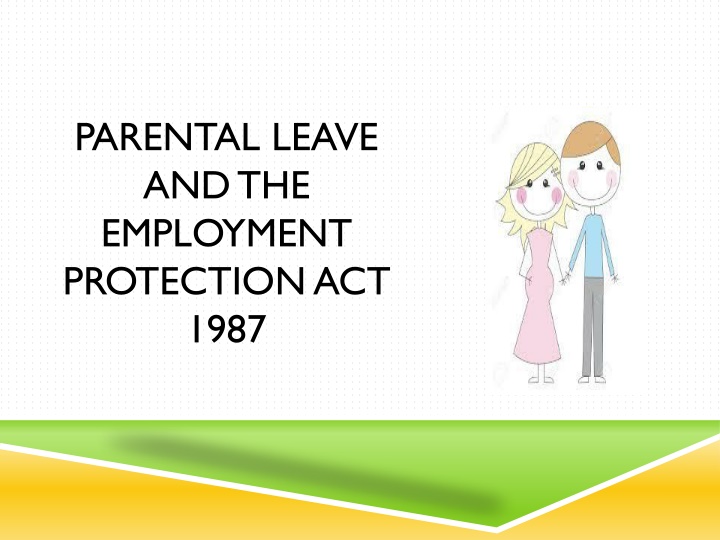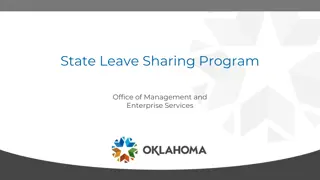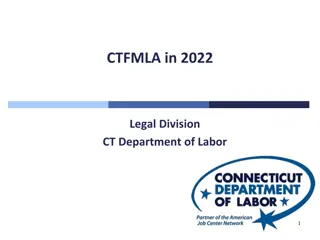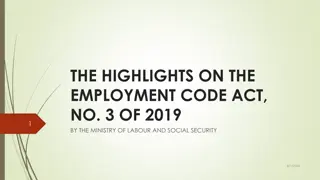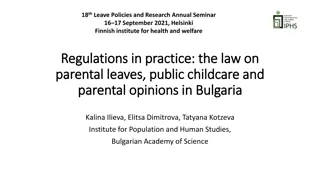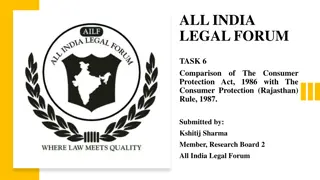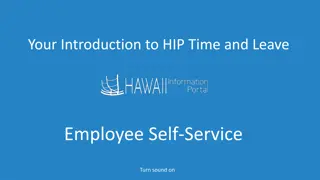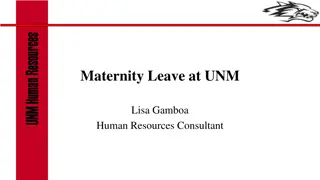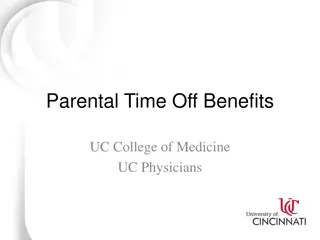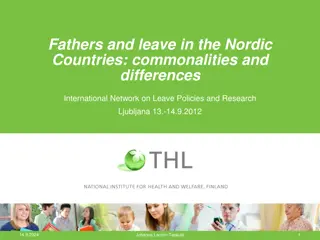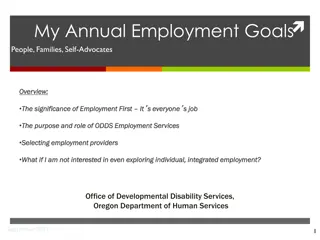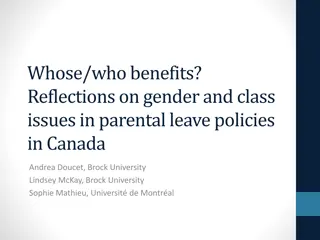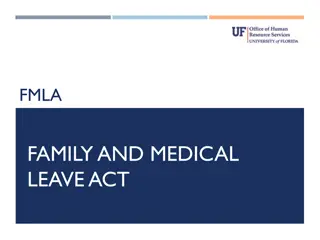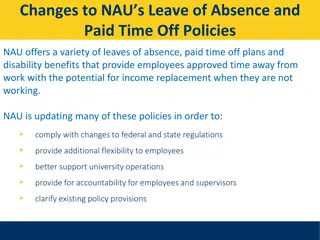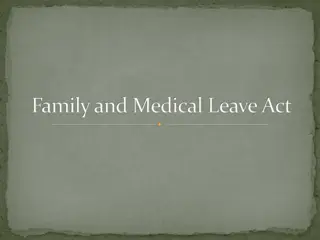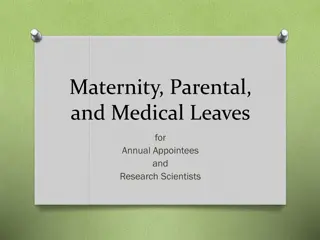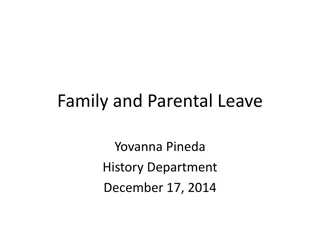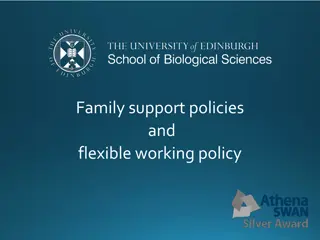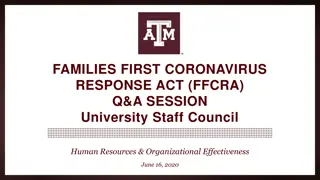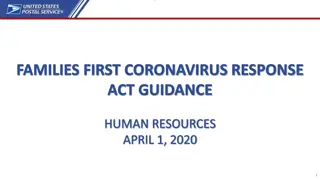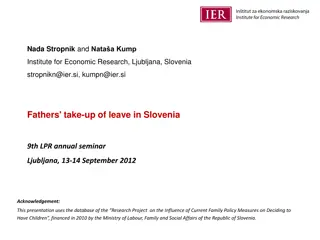Parental Leave and Employment Protection Act 1987 Overview
The Parental Leave and Employment Protection Act 1987 provides minimum entitlements for parental leave, protects employees during pregnancy and parental leave, and allows for up to 22 weeks of parental leave payments. Eligibility criteria include female employees with a baby, their spouses or partners, and employees in permanent care of a child under 6 years. The act includes provisions for different types of parental leave, such as primary carer leave and extended leave, and sets requirements for returning to work after parental leave. Unpaid leave unless otherwise agreed by the employer. Various employment tests and notice periods apply for eligibility and return to work. The Act underwent updates in 2016, 2017, and 2018 to enhance coverage and entitlements for employees.
Download Presentation

Please find below an Image/Link to download the presentation.
The content on the website is provided AS IS for your information and personal use only. It may not be sold, licensed, or shared on other websites without obtaining consent from the author.If you encounter any issues during the download, it is possible that the publisher has removed the file from their server.
You are allowed to download the files provided on this website for personal or commercial use, subject to the condition that they are used lawfully. All files are the property of their respective owners.
The content on the website is provided AS IS for your information and personal use only. It may not be sold, licensed, or shared on other websites without obtaining consent from the author.
E N D
Presentation Transcript
PARENTAL LEAVE AND THE EMPLOYMENT PROTECTION ACT 1987
STRUCTURE OF PRESENTATION Purpose of the Act Employee eligibility for parental leave Types of parental leave Special leave Primary carer leave Partner s leave Extended leave Negotiated carer leave Keeping in touch days Returning / Not returning to work Effects on Annual holiday entitlement when returning from parental leave
PURPOSE The purpose of this Act is to; Set minimum entitlements with respect to parental leave for male and female employees; Protect the rights of employees during pregnancy and parental leave; Entitle certain persons up to 22 weeks of parental leave payments. Please note that the Act was updated on the 1 April 2016 to provide greater coverage and entitlements to employees and again on 1 June 2017 to allow employees to take unused leave prior to Parental Leave commencing. Extensions and updates were implemented as of 1stJuly 2018 NOTE: All leave provided under this ACT is UNPAID unless the employer has agreed otherwise.
ELIGIBILITY FOR PARENTAL LEAVE Female employees having a baby, their spouses or partners (regardless of sex or status) Employees and their spouses or partners (includes a married, civil union or de facto relationship with a same-sex partner), who will begin to permanently care for a child under 6 years who is not their natural child. You can take parental leave multiple times, as long as 6 months have lapsed between the return to work date and the arrival date of the next baby. The amount of time that an employee can take may be subject to the amount of employment service they have provided in months.
12 Month Employment Test You must have worked for the same employer for an average of at least 10 hours a week for the 12 months just before your baby s due date (or the date you assume responsibility for the care of a child under 6 years on a permanent basis). 12 months continuous service Up to 52 weeks extended leave Employee can return to work by giving 21 days notice, if criteria met. 3 month notice by employee of their intention to take PL Employee has 21 days before returning to work to inform employer that they will return. 21 day notice by employer that employee is eligible for PL and whether their job can be kept open.
6 Month Employment Test You must have worked for the same employer for an average of at least 10 hours a week for the 6months just before your baby s due date (or the date you assume responsibility for the care of a child under 6 years on a permanent basis). Employee has worked 6 up to 12 months continuous employment 22 weeks paid by the government through IRD
TYPES OF PARENTAL LEAVE Special leave Primary carer leave Partner s leave Extended leave Negotiated carer leave NOTE: All leave must be taken in the first year after the birth or adoption.
SPECIAL LEAVE Prior to taking primary carer leave, female employees who are pregnant can take up to 10 days unpaid special leave for reasons relating to her pregnancy. Such as attending; Antenatal classes Doctors appointments Midwife appointments Scans
PRIMARY CARER LEAVE Is available to female employees who are having a baby or; Her spouse or partner if he or she has all or part of the birth mother s parental leave payment transferred to them, and Employees who are going to have the primary responsibility for the care, development and upbringing of a child under 6 years on a permanent basis. It does not include temporary arrangements such as fostering children.
Primary carer leave can be taken for up to 22 weeks Must be taken in one continuous period. Primary carer leave can t be taken if the employee has already taken any period of parental leave or similar leave in relation to that child. The employee can start their primary carer leave up to 6 weeks (or earlier with the employer s consent) before the baby s due date or the date on which the employee will become the primary carer of the child).
EARLY PRIMARY CARER LEAVE Pregnant women can start their primary carer leave earlier if: the baby is born before her scheduled leave, or directed by a doctor or midwife, or the employer considers that the pregnant employee s work is unsafe, or her performance is inadequate, due to her pregnancy; and the employer can t temporarily transfer her to another suitable job.
PARTNERS LEAVE If you are a spouse or partner who meets the eligibility criteria, then you will be able to receive partners leave. (previously paternity leave) 6 month employment test 1 weeks unpaid partner s leave 12 month employment test 2 weeks unpaid partner s leave
PARTNERS LEAVE TIME FRAMES Previously Paternity leave. Starting 21 days before the due date of the baby, or the date your partner or spouse becomes the primary carer for a child under 6 years, and Ending 21 days after the baby is born (unless the baby is discharged from a hospital more than 21 days after the birth, in which case the partner s leave time frame ends on the day the child is discharged) or the date your partner or spouse becomes the primary carer for the child. If you and your employer agree, you can start your partner s leave at any time.
EXTENDED LEAVE Employees who meet the 12 month criteria may take up to 52 weeks extended leave, or Employees who meet the 6 month criteria may take up to 26 weeks in total If one parent meets the 12 months criteria and the other parent the 6 months criteria then the person who has only worked for 6 months cannot take more than 26 weeks of the total 52 weeks (less the number of weeks primary carer leave taken up to 22 weeks) available to the couple.
STARTING EXTENDED LEAVE At any time after you end your primary carer leave, or At any time after you end your partner s leave, or On any date agreed with your employer, or If you can take primary carer or partner s leave but choose not to, then you can start extended leave either when you finish work to have the baby (known as the date of confinement) if the child is born to you or your spouse or partner, or the date you or your spouse or partner becomes the primary carer in respect of the child in all other cases. You can finish your primary carer or partner s leave, go back to work, and then take extended leave later.
ENDING EXTENDED LEAVE For an employee who has (and/or their spouse or partner has) worked for 12 months, extended leave must end by the: Date the child turns 1 year if the child is born to the employee or their spouse or partner, or 12 months anniversary of the employee or their spouse or partner becoming the primary carer in respect of the child.
For an employee who has only worked for 6 months (and whose spouse or partner has not worked for 12 months), extended leave must end by the: date the child turns 6 months if the child is born to the employee or their spouse or partner, or 6 months from the date the employee or their spouse or partner became the primary carer of the child.
For an employee who has (and/or their spouse or partner has) worked for 12 months, extended leave must end by the: date the child turns 1 year if the child is born to the employee or their spouse or partner, or 12 months anniversary of the employee or their spouse or partner becoming the primary carer in respect of the child.
NEGOTIATED CARER LEAVE Negotiated carer leave is a period of unpaid leave from work which an employee can ask for: At least 3 months before the baby s due date, if the employee or their spouse or partner is pregnant, or 14 days before an employee becomes the primary carer of a child.
INTRODUCTION OF KEEPING IN TOUCH DAYS April 1st2016 also saw the introduction of Keeping in touch days To be agreed between parties Worked during the 22 weeks of paid parental leave or more for preterm babies. Only after baby is 29 days 52 hours maximum not to be worked within the 28 days after the baby is born. This increased from 40 as at 1 July 2018, and is expected to increase to 64 hours from 1 July 2020. If the employee does work more than 52 hours OR works within 28 days of the birth, then they are considered to be back at work and the entitlement to parental leave will be cancelled and any payment made will be considered an overpayment.
KEEPING IN TOUCH WHILE RECEIVING PRE TERM PAYMENT Keeping in touch hours earned while receiving pre-term baby payments are not included in the standard keeping in touch day calculation. They are in addition to. Pre term keeping in touch hours are 3 hours multiplied by the weeks the employee has received the pre-term baby payment. If the employee does work more than 3 hours multiplied by the weeks they receive the pre term baby payment, it will be considered an overpayment BUT parental leave will not be effected.
MISCARRIAGE, STILL BIRTH AND NEONATAL DEATH Under the law, if your baby is born dead before the end of the 20th week of pregnancy, it is called a miscarriage. If your baby is born dead after the 20th week of pregnancy it is called a stillbirth. Either of these occurrences will still allow the mother to observe paid parental leave, however, they will not be entitled to extended leave. This is because extended leave relates to the care of a child.
COMING BACK TO WORK EARLY An employee can come back to work early under some circumstances; these include the loss of a child as result of; miscarriage, stillbirth or illness have made arrangements for your child s care have opted for adoption. If the employer agrees, an employee may also return to work early in any other circumstances. In all cases, the employee will need to write to the employer 21 days before the employees intention to return.
SPECIAL LEAVE (10 DAYS UNPAID) PRIMARY CARERS LEAVE (22 WEEKS) PARENTAL LEAVE EXTENDED LEAVE (52 WEEKS LESS PRIMARY CARERS LEAVE) PARTNERS LEAVE (2 WEEKS UNPAID)
HELPFUL INFORMATION https://www.employment.govt.nz/leave-and-holidays/parental- leave/parental-leave-scenarios/ https://www.employment.govt.nz/assets/Uploads/tools-and- resources/documents/parental-leave-and-payment-eligibility- factsheet.pdf
ANNUAL LEAVE PAYMENTS Can an employee use their annual leave prior to going on parental leave? Does the employees entitlement change if they reduce their working profile when they return? What happens when an employee becomes entitled to annual leave while on parental leave? How is annual leave calculated after a period of parental leave? What happens to annual leave entitlement if the employee doesn t return to work after parental leave? Do the Keeping In Touch hours effect the employees annual leave rate if they choose to resign after their period of parental leave?
PAYROLL SCENARIOS TO DEAL WITH 1. Employee takes leave owing to them and then takes parental leave. 2. Employee returns to work and then takes annual leave. 3. Employee does not return to work and therefore employment is terminated. 4. Employee works keeping in touch (kit) hours but then chooses not to return to work so the employment is terminated.
EMPLOYEE TAKES LEAVE OWING TO THEM AND THEN TAKES PARENTAL LEAVE Employees who want to receive parental leave payments can now use their paid leave (e.g. annual leave, alternative days, special leave or time off in lieu) first. Their parental leave payment period can start at the end of their leave, even if it is later than the child s arrival or due date. Before 1st June 2017, the parental leave payment period couldn t start later than the child s arrival.
EMPLOYEE RETURNS TO WORK AND THEN TAKES ANNUAL LEAVE. There are two elements to look at when we have an employee who returns to work after parental leave, these are; Entitlement to Annual leave. Payment of Annual leave.
WHAT HAPPENS WHEN AN EMPLOYEE BECOMES ENTITLED TO ANNUAL LEAVE WHILE ON PARENTAL LEAVE? An employee is still entitled to annual leave while on Parental Leave. As discussed previously, the employee s employment is considered continuous. Any entitlement that is earned while on Parental Leave will be based on the employees agreed terms and conditions of employment. Hours or days of leave will be based on the employees working profile.
ANNUAL LEAVE THAT WAS OUTSTANDING PRIOR TO GOING ON PARENTAL LEAVE. Any outstanding annual leave that the employee had prior to commencing annual leave, if taken once the employee returns to duties, will be paid at the higher of; The employees average weekly earnings versus The employees ordinary weekly pay Average weekly earnings VS Ordinary weekly pay
PAYMENT OF LEAVE THAT HAS BEEN EARNED WHILE ON PARENTAL LEAVE OR IN THE 12 MONTHS FOLLOWING. The annual leave entitlement that has been earned while on parental leave or the 12 months following, is to be paid at the average weekly earnings only. The average weekly earnings will be impacted (reduced) because of the effect of nil earnings. The more time the employee has off on parental leave, the lower the average weekly earnings rate becomes. Average weekly earnings only!
HOW IS ANNUAL LEAVE CALCULATED AFTER A PERIOD OF PARENTAL LEAVE? Any annual leave earned while on parental leave or the 12 months following, will be paid at the employees average weekly earnings until it has been exhausted. The standard process of comparing the ordinary weekly pay and average weekly earnings, and paying the higher does not apply to these entitlements. These entitlements stand alone, and the average weekly rate should be applied to them, until all units have been used by the employee.
WHAT HAPPENS TO ANNUAL LEAVE ENTITLEMENT IF THE EMPLOYEE DOESN T RETURN TO WORK AFTER PARENTAL LEAVE? If an employee does not return to work, then their employment is deemed to have terminated on the last day before they commenced Parental Leave. Annual leave calculations will be performed looking back 52 weeks from the last period of pay.
WHAT HAPPENS TO THE ANNUAL LEAVE RATE IF THE EMPLOYEE HAS WORKED KEEPING IN TOUCH HOURS? If the employee has worked keeping in touch hours but then chooses not to return to work and has outstanding annual leave, then the employee is deemed to have terminated their employment, from the commencement of the parental leave. For calculating any outstanding annual leave, then the average weekly rate will look at the 52 weeks prior to the commencement of the parental leave.
Calculation of annual holiday pay if employment ends and entitlement to holidays has arisen. (sec 24 - Holidays Act 2003) (1) Subsection (2) applies if (a) the employment of an employee comes to an end; and (b) the employee is entitled to annual holidays; and (c) the employee has not taken annual holidays or has taken only some of them. (2) An employer must pay the employee for the portion of the annual holidays entitlement not taken at a rate that is based on the greater of (a) the employee s ordinary weekly pay as at the date of the end of the employee s employment; or (b) the employee s average weekly earnings during the 12 months immediately before the end of the last pay period before the end of the employee s employment.
Failure to return to work (sec 46 Parental Leave and Employment Protection Act 1987 If an employee who takes up parental leave and whose position is kept open by the employer (a) fails, without good cause, to return to work at the end of that period of parental leave; or (b) informs the employer, before the end of that period of parental leave, that the employee has decided not to return to work at the end of the period of parental leave, the employee s employment shall, subject to any agreement between the employer and the employee, be deemed to have been at an end as from the day on which the period of parental leave began.
ANNUAL LEAVE EARNED WHILE ON PARENTAL LEAVE. Any annual leave earned while on parental leave and in the 12 months following the return to work, must be paid using the average weekly pay. Annual leave cannot be taken during a period of parental leave, but an employee may become entitled to leave during this time off. If an employee has no outstanding leave when they start parental leave and they have received their entitlement while on parental leave, these 4 weeks of annual leave will be paid at the Average Weekly Pay rate only. This means that if the employee has been away for almost a full year, their rate of pay may be very minimal. The use of the Average Weekly Pay earnings calculation may extend to 2 entitlements the legislation refers to whilst on parental leave and the 12 months following the return to duties.
ADMINISTRATION OF APPLICATIONS You cannot decline parental leave requests, but you can decline to hold open the applicant s position if; Your employee will be gone longer than four weeks, and; You can prove the position is crucial to your business, and; You can prove it s not possible to find short-term cover for the position. Refer to Section 40 and 41 of Parental Leave and Employment Protection Act.
WHEN EMPLOYEE APPLIES FOR PARENTAL LEAVE Ensure they are aware of their Parental Leave entitlements. Therefore, it is imperative that you understand these entitlements. In addition to our information above, you can find some more information on parental leave, http://www.business.govt.nz/staff-and- hr/managing-employees/holidays-and-leave/parental-leave Approve or decline their request within 21 days; Confirm the employee s leave arrangements in writing Once you know how long they intend to be gone, you can consider how you ll fill their position. You can hire someone on a fixed-term agreement to cover for parental leave, or you might want to hire a contractor.
